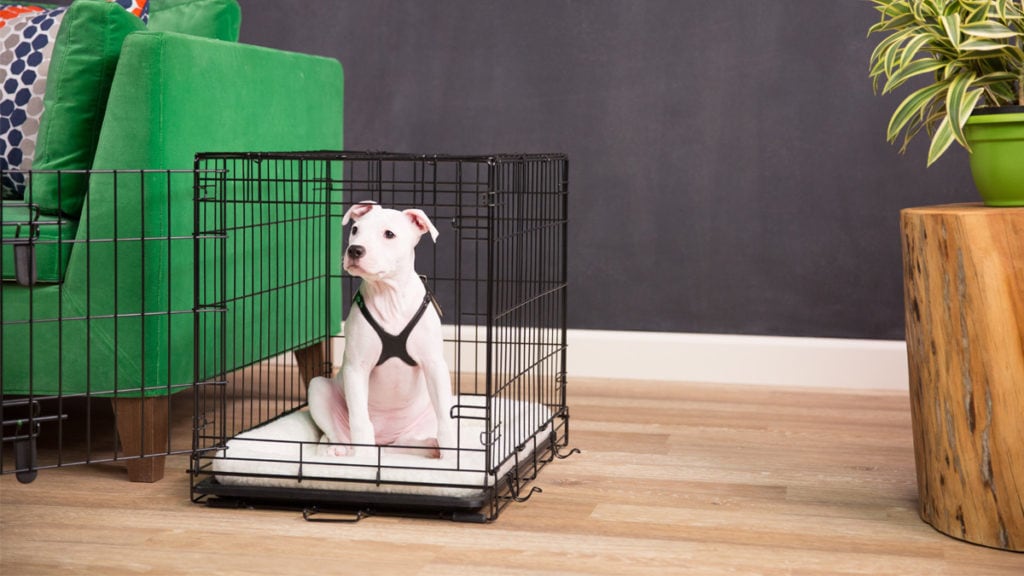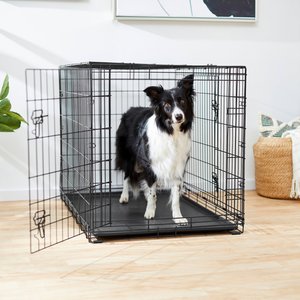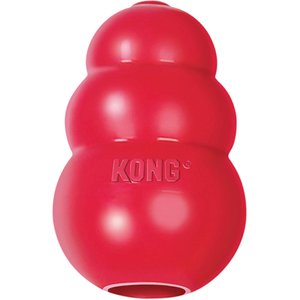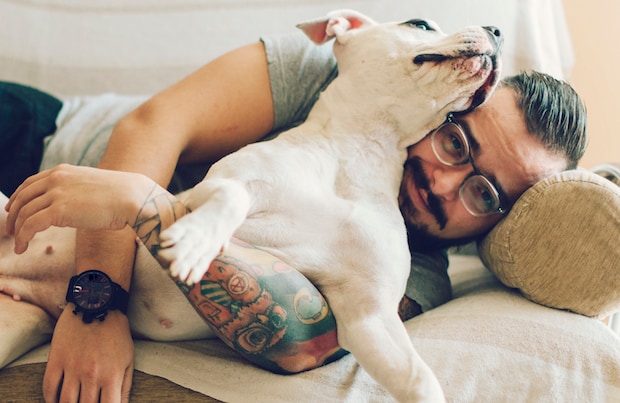Contributed by Irith Bloom, faculty at Victoria Stilwell Academy and certified animal trainer with multiple certifications, including CPDT-KSA, CDBC, VSPDT, KPA CTP, and CBATI.
Ease Your Pup’s Crate Training Anxiety
If you have a dog, you’ve probably heard the phrase “crate training.” Clients ask me how to crate train a dog all the time, in fact! The term “crate training” can be used in a couple of different ways, though, and it’s important to know which one people are referring to. Two common meanings are teaching a dog to be comfortable when they’re put inside a crate and using a crate to house-train a dog. However, it is important to note that if a dog is not trained to be comfortable in a crate to begin with, it can be difficult to use a crate for house-training.
This article focuses on how to get a dog used to a crate using positive reinforcement dog training. Being comfortable in a crate is not just important for dogs who need house-training. Any dog may need to be crated at a veterinary hospital or a boarding facility. Also, if you need to evacuate your home for any reason—here in California, for example, many people evacuated due to fires—it’s important to be able to crate your dog at an emergency shelter. The bottom line is that crating comfortably is a skill every dog should have.
How to Crate Train a Dog
- Create a comfortable environment. Fortunately, most dogs can quickly learn to enjoy being in a crate, as long as you introduce the crate properly. Start by creating a comfortable crate environment. For example, you can take a dog crate and put a dog bed in the bottom to make the crate nice and cozy.
- Tie the door back. Once that’s done, tie back the door of the crate so it can’t accidentally swing shut. Then drop a few treats on the bed. Wait for your dog to notice the treats and wander into the crate. As soon as she does, drop more dog treats into the crate. Continue to do this—dropping dog treats in the crate any time you notice it is “empty,” and every time you see your dog in there—for several days.
- Add a chew toy. You should soon notice that your dog is hanging out in the crate a lot. Once she’s going in there regularly, you can start to reward her for being in the crate with a longer-lasting chew item, such as a bacon-flavored Benebone. Dog chew toys like this encourage dogs to settle in and relax where they are, which will help as you move into the next phase of crate training—closing the door.
- Start closing the door. Once your dog is wandering into the crate and settling in to chew on a regular basis, you can temporarily unhook the string from the door and start to swing the door partway shut while your dog is busy with the chew toy in the crate. If she seems completely relaxed as you do this, you are ready to move on to shutting the door completely.
Getting Your Dog Used to a Shut Door
If your pup seems stressed as you move the door, though, try the following: Say the word “door,” then simply touch the top of the door (without swinging it shut), and throw a treat into the crate through the door. If your dog continues to chew calmly while you touch the door, move on to saying “door” and then gently pushing the door partway closed before reopening it and tossing in a treat.
Continue in this way, working in small steps and making sure your dog continues chewing each time you touch or move the door, until you are able to shut the door all the way while your dog continues chewing.
NOTE: If your dog tries to leave her dog crate, let her. She’ll feel a lot more comfortable if she knows she can leave whenever she wants. In time, she won’t want to leave at all.
- Try locking the door. Once your dog is comfortable in the crate and chewing on her toy when you shut the door, you can begin to lock the door briefly—again making sure she continues chewing as you lock the door. After you lock the door, drop a treat into the crate. Then unlock the crate and open the door.
NOTE: Somewhere along the line, you may want to start varying the chew item your dog has in the crate. Two excellent choices are Classic Kong Toy and the Bionic Bone Dog Toy. You can put food inside these toys, and your dog then has to work to get them out. You can also give your dog multiple chew items in the crate at the same time. - Keep the door shut for longer. Now that your dog is comfortable with you shutting and locking the door, it’s time to work on keeping the door shut for longer periods. Start out by locking the door, waiting one second, and then dropping a treat in the crate before reopening the door. Gradually build up to longer and longer periods with the door shut and you standing beside the crate, dropping treats once in a while.
NOTE: If you’ve been saying “door,” continue to use that signal every time you shut the door, whether or not you lock it, and whether it’s shut for one second or 30 minutes. - Step away briefly. The final stage of crate training involves locking the door and then stepping away briefly, before returning to drop a treat in the crate and unlock and open the door. Build up very gradually from just a half-step away to greater and greater distances. Your dog should remain settled and continue chewing at all times. If your dog stops chewing or tries to get out of the crate, the current level of difficulty is too high; go back to the previous steps and build up again, even more gradually. In time, you’ll be able to leave the room, and even the house, while your dog is settled calmly in the crate.
Crate training using positive reinforcement dog training can be a bit time-consuming, but it’s worth it. It teaches your dog that good things happen while in the crate, and that it’s a nice place to relax—which is extremely helpful any time your dog has to be crated.
Share:















